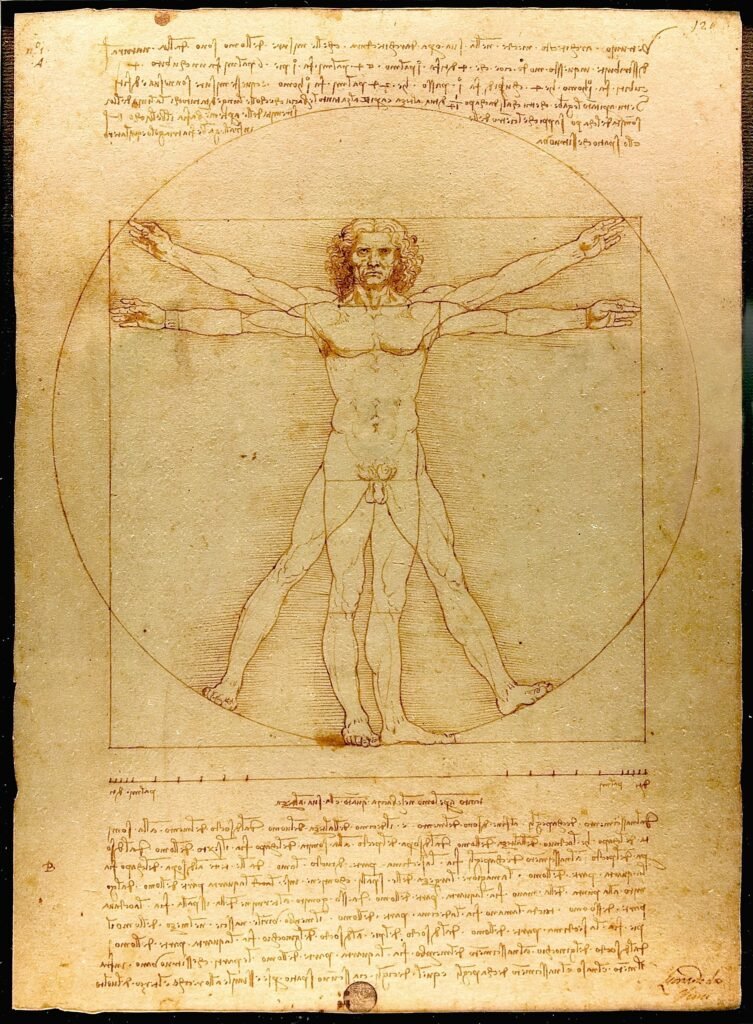
Background of the Vitruvian Man Theory
The Vitruvian Man Theory originates from the work of prolific inventor and artist Leonardo da Vinci. At the core of this theory is the idea that the human body is a model of perfect proportion, a concept that stems from the teachings of ancient Greek architect Vitruvius, the theory’s namesake. Vitruvius believed that ideal architectural structures must imitate the proportions and symmetry seen in the human body. Captivated by this concept, Leonardo da Vinci sketched what is now known as the ‘Vitruvian Man’.
His infamous pen and ink drawing depicts a man in two superimposed positions within a circle and square, symbolizing the belief that ‘human proportions should dictate the proportions of a temple’. Today, this sketch not only serves as an embodiment of the traffic exchange between art and science during the Renaissance period but also continues to stir debate about its physiological accuracy.
What is the Vitruvian Man Theory?
Historical Context and Leonardo da Vinci’s Role
Leonardo da Vinci, the renowned Italian artist and thinker of the Renaissance period, played a significant role in formulating and popularizing the Vitruvian Man Theory. He was hugely inspired by the works of earlier intellectuals like Vitruvius, a Roman architect who emphasized the mathematical proportions in the architecture of natural human form and developed the Vitruvian Man Theory.
By virtue of his precise drawings and elaborate notes, da Vinci further validated the theory. Depicted in his famous work, ‘The Vitruvian Man’, the artist succeeds in creating a stance wherein a male figure fits both inside a square and a circle, signifying the blend of earthly existence and spiritual enlightenment, respectively. This artwork, influenced heavily by Vitruvian principles, etches da Vinci’s belief in the divine correlation between the human form and the universe, hence portraying the Vitruvian Man Theory.
Concept and Mathematical Proportions in the Vitruvian Man
The Vitruvian Man, created by Leonardo da Vinci, illustrates the correlations of ideal human proportions with geometry as described by the ancient Roman architect Vitruvius. This artpiece, based on Vitruvius’ theories, is grounded in the principle that the human body can be evenly divided into a circle and a square—a perfect blend of two of the most fundamental geometric shapes. Regarding mathematical proportions, the Vitruvian Man’s height is equal to the arm span, signifying the range of a perfect square.
Meanwhile, the navel’s location marks the circle’s center when the figure’s limbs are outspread. As such, this translates to the idea that a well-constructed human body mirrors the universal harmony found in mathematical ratios and geometrical shapes. Therefore, the Vitruvian Man theory underscores the symbiotic relationship between art, science, and the natural world. However, it has been debated for centuries whether the exact proportions are anatomically accurate universally.
Analyzing the Vitruvian Man Theory
Existence of Perfect Proportions in Humans
Leonardo da Vinci’s Vitruvian Man serves as an iconic representation of the blend of art and science during the Renaissance. The illustration showcases what Da Vinci considered ideal human proportions, thus suggesting that the ‘perfect’ human body could be fittingly mapped onto both a circle and a square. While appealing as an idea, the universality of these specific ratios and their prevalence across all human bodies is questionable.
Biological diversity, individual genetics, and environmental factors all contribute to significant variation in the human physique, often deviating from the ‘perfect’ proportions indicated by Da Vinci. Additionally, recent anthropometric studies have shown significant racial and temporal differences in these proportions. Hence, while the ideal of the Vitruvian Man might stand as an artistic symbol of perfection, truly uniform proportions are unlikely to exist in reality. Nevertheless, the intersection of symmetry, geometry, and biology continues to inspire fascination in both the scientific and artistic realms today.
Relevance of the Circle and Square in the Theory
In the Vitruvian Man theory, Leonardo da Vinci uses a circle and a square to define humans’ connections with nature and the universe. The circle, representing the spiritual cosmos, signifies the intangible elements of human life—spirit, mind, and emotions—symbolizing our seamless continuity with the universe. On the other hand, the square represents the tangible, physical world we inhabit—our bodies, material possessions, and the earthly realm—hence demonstrating a sense of rigidity and structure.
Da Vinci’s choice of these two geometric shapes echoes the ancient belief in the sacredness of circles and squares. Through demonstrating that man fits perfectly within both shapes, da Vinci suggested the idea of ‘Microcosm and Macrocosm’, that humans are the epitome of the universe. Though simplistic in presentation, these involved geometric shapes bear profound implications for our understanding of human nature and our place within the cosmos.
Scientific Evidence Supporting or Refuting the Theory
Modern Anthropometric Studies and the Vitruvian Man
Recent anthropometric studies have examined the Vitruvian Man theory, a concept conceived by Leonardo da Vinci, illustrating the symmetry and balance in human proportions. These modern studies use scientific approaches and precise body measurements to compare with the ratios posited in Da Vinci’s concept. As per da Vinci, the height of a human is equivalent to the span of their arm; however, results have varied in correlation.
Though some individuals meet these criteria, there are deviations due to genetic diversity, age, and ethnicity that challenge the universality originally assumed. There’s also an inconsistent correlation regarding the navel’s positioning as the body’s center, mainly influenced by age and body mass differences. Despite these inconsistencies, da Vinci’s Vitruvian Man theory retains its value, offering significant insights into the idealized human body proportions of the Renaissance era. Yet it should not be considered infallible or universally applicable, as per modern anthropometric study findings.
Criticisms and Controversies Surrounding the Theory
Several experts have raised questions and objections to the validity of the Vitruvian Man theory. Critics agree that while Leonardo da Vinci’s calculations may be accurate for the perfect proportions of an idealized human male, they don’t necessarily hold true for all individuals. There is significant natural variation in the human body, and so these ratios can’t be universally applied. Some critics have emphasized how Da Vinci overlooked certain measurements while considering other ratios.
Furthermore, scientific studies analyzing da Vinci’s theory have shown mixed results. A 2019 study published by the American Journal of Medical Genetics found da Vinci’s proportions inaccurate, specifically highlighting differences in arm length and the belly button’s location. On the contrary, a few studies, like the one published in the journal Medical Hypotheses, suggested a correlation between da Vinci’s ideal proportions and the healthiest human beings. However, these studies don’t entirely validate the theory either. Such conflicting evidence and criticisms add to the ongoing debate regarding the truth of the Vitruvian Man theory.
Impact of the Vitruvian Man Theory on Arts and Sciences
Influence on Renaissance and Contemporary Art
Leonardo da Vinci’s Vitruvian Man is both a testament to mathematical precision and a symbol of the harmonious bond between art and science. Its resonance with artists and scientists in the Renaissance era went beyond the confines of aesthetics or mathematics. These concepts inspired a renewed emphasis on proportion and symmetry, serving as the blueprint for renowned architecture and masterpieces of the time. Fast forward to the contemporary world, and this iconic sketch continues to be a profound artistic allegory of human potential and a metaphor for universal balance, nodding at Da Vinci’s interdisciplinary genius and encapsulating the spirit of the Renaissance.
Impact on Science, Architecture, and Design
The Vitruvian Man’s influence permeates through different fields of study, seemingly connecting unrelated disciplines through its underlying theory. In science, it affected the study of human anatomy, reinforcing proportional relationships between various body parts. Opinions adopted from this theory added sophistication and precision to modern medical procedures. It equally played a pivotal role in architecture, paving the path for constructions based on human scale and yielding aesthetically pleasing and functional structures. The theory also affected design, instigating the premise of user-centered formulating, a touchstone of modern ergonomics and product development. This multidisciplinary impact underscores the timeless validity of the Vitruvian Man concept.
Conclusion
Recap of the Vitruvian Man Theory’s Validity
The validation of the Vitruvian Man theory has stirred scientific and artistic discussion for over 500 years. After extensive evaluation, many experts concur that Da Vinci’s representation of the human body’s proportions represents an ideal rather than a reality, as human proportions can vary widely. Despite being a mathematical achievement, it doesn’t wholly depict physical human variability. Yet, the concept has influenced numerous aspects of art, architecture, and even medical study, supporting its timeless significance. Therefore, while it may not universally replicate human proportions, its contribution to multiple fields signifies its enduring relevance and, in that sense, its validity.
Closing Remarks
In wrapping up, it is crucial to note that the accuracy of the Vitruvian Man Theory largely relies on one’s perspective and the context in which it’s analyzed. There’s consensus about its influence and significance in art, architecture, and human anatomy understanding through Da Vinci’s time and beyond. However, the notion of an ‘ideal’ human proportion as proposed is subject to biological and physiological variations, thereby challenging its universality. Thus, the validity of the Vitruvian Man Theory will always remain a riveting topic for debate within the confluence of art, science, and philosophy, underscoring its enduring intrigue.



